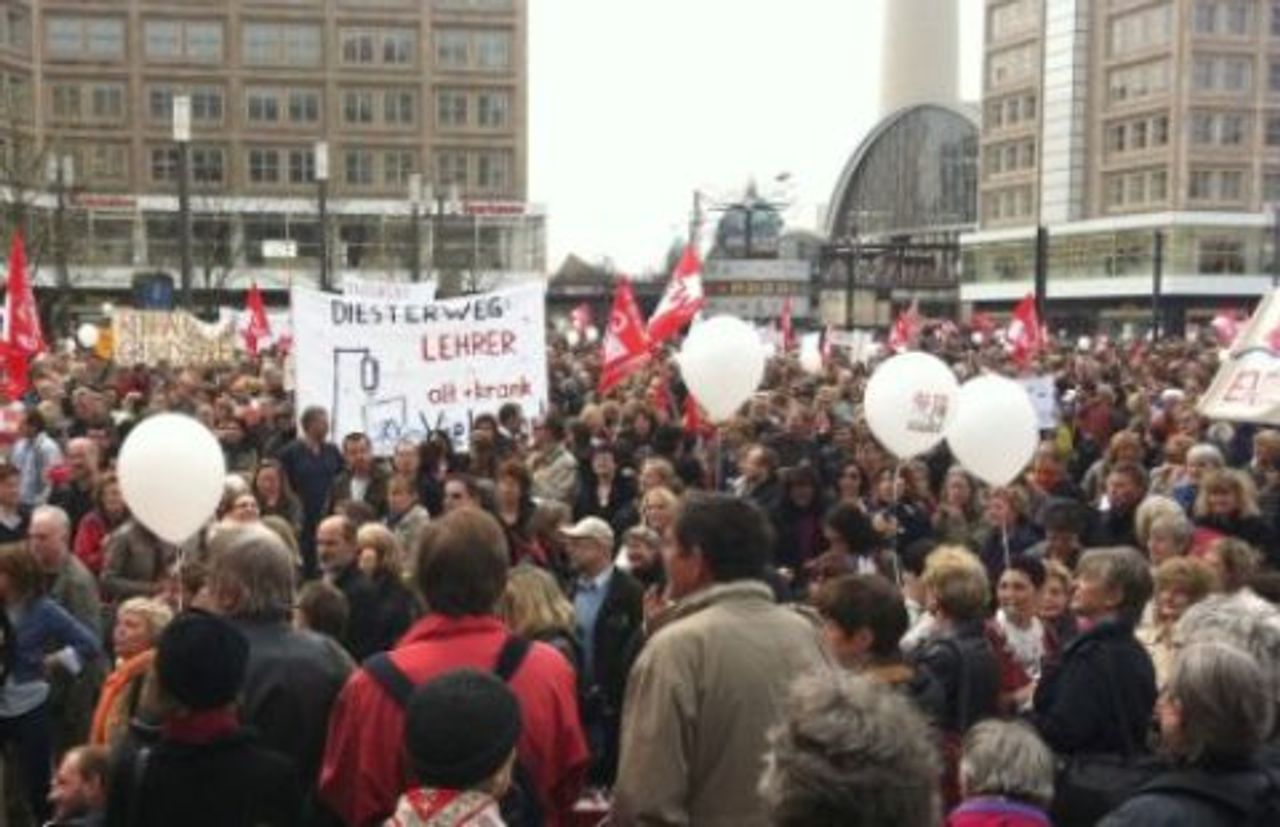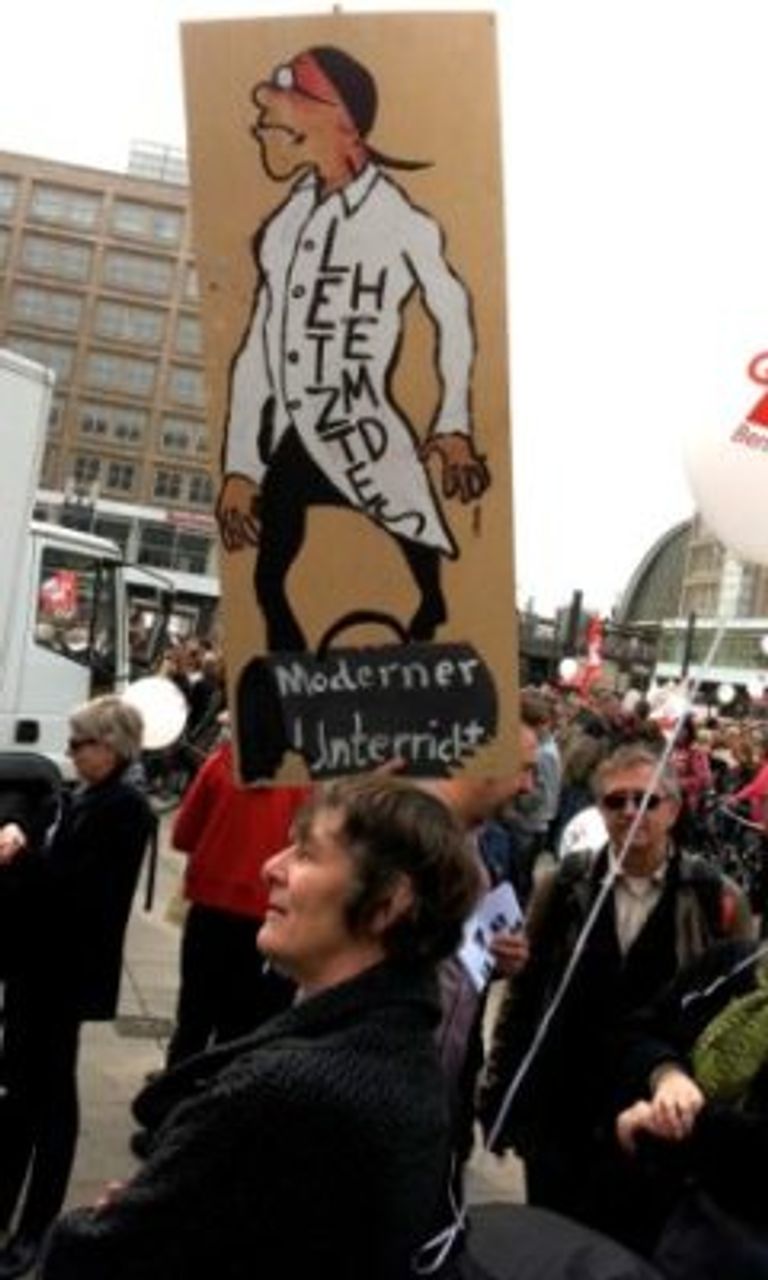On Tuesday, April 5, nearly 6,000 teachers followed the call of the Union for Education and Science (GEW) to support a demonstration against the education policy of the Social Democratic Party-Left Party city government in Berlin. The march began at the Friedrichstrasse urban transit station and then moved to Alexanderplatz, where a brief rally took place.
 Protest of teachers in Berlin
Protest of teachers in BerlinThe GEW had called for the demonstration because after almost 10 years of continuous attacks on the working and living conditions of teachers by the SPD-Left Party coalition in the Berlin Senate, the mood among teachers both inside and outside the union has reached a breaking point. The union has always dutifully ensured that the attacks have been pushed through against teachers, and their anger and indignation kept under control. In September, Senate elections will be held in Berlin, and the GEW regards its most important task as smoothing the path for the SPD-Green Party until then.
From the beginning, the demonstration was designed to let off some steam and to direct the teachers’ protest into harmless channels. The union demands on the demonstration were limited to a call for a small reduction in teaching hours for teachers over 55. But this is only a small aspect of the catastrophic situation facing teachers in Berlin.
At the same time, the union is stressing that more wide-reaching aims could not be addressed currently. Other educators and social workers, who are affected by similar cuts as the teachers, complained to the union in a letter sent in advance that the demands being raised on the demonstration only applied to teachers. The SPD-Left Party Senate also threatened sanctions against any teachers who participated on the demonstration during class time.
A survey in February of GEW members who are teachers had already indicated a willingness to take industrial action; however, the union’s regional executive had said it only expected some 2,000 striking teachers to demonstrate. The executive also sent out a circular saying that low interest meant there “could not be any thought of further [strike] action”. Clearly, the union had hoped to use low participation on the demonstration as justification for their prior decision not to take any further industrial action. Just a few months earlier, it had signed up to a new contract with the Senate that guaranteed exactly this.
 A sign on the demonstration
A sign on the demonstrationThe fact that nearly 6,000 participants came to the demonstration was not down to the efforts of the GEW, as it cut across the union’s plans to sabotage any real protest against the Senate. In interviews with reporters from the World Socialist Web Site, demonstrators clearly expressed that improving the conditions for older teachers was not the only issue that concerned them. They were outraged that they have faced years of worsening working conditions and called for a fundamental change in education policy.
The Socialist Equality Party (Germany) issued a statement to protesters headlined “Teachers in Berlin face political tasks”.
Demonstrators expressed few illusions in the SPD-Left Party Senate, which 10 years ago when it first took office had presented itself as a supposedly left-wing alternative to the austerity policies of the other bourgeois parties. Instead, anger with the policies of the SPD and Left Party was almost tangible. “If any confidence remained in the SPD-Left Party Senate there would not be as many people here now”, said one 50-year-old teacher, describing the mood of many demonstrators.
One example of how SPD-Left Party education policy is regarded were the comments of two primary school teachers who have worked in Berlin since the late 1980s:
“We are now 50 and still have 17 years ahead of us under the new proposals. And it is a horror to imagine having to work for another 17 years under the conditions that have been created in recent years.
“Everywhere is being cut; they’re always making reforms that no one can support because of the cuts and too few staff. And the people who are still there are simply too old. There will be a gap in five years, and young people won’t be filling it. We already have quite a few who are not trained as teachers but have entered by various side branches. There’s always talk about PISA [the OECD programme for international student assessment] and the importance of education, and we don’t even have trained teachers.”
In particular, many younger teachers pointed to the massive loss of earnings they have to endure because the SPD-Left Party coalition has stopped tenure for teachers. They were particularly angry that the Senate has now begun to bring in 1,000 staff to Berlin from other states, instead of paying its own teachers decently.
A leaflet produced by teachers described this behaviour as “spitting in our faces” and the talk of Berlin’s “quality and education drive” as “hypocritical lies”. They accused the GEW of not standing up for the principle of “equal pay for equal work”. The sellout of the last great teachers’ protests in Berlin by the GEW was still fresh in many teachers’ mind.
Teachers from Leonardo da Vinci High School in Berlin-Neukölln also distributed their own leaflet on the demonstration drawing attention to the intolerable situation at this school. It said that “the limits of endurance...have long been exceeded”, and addressed an appeal to all teachers, parents and students in Berlin to take action “together against the injustices in our schools”. Such initiatives, which are now developing independently of, and sometimes even in open hostility towards, the trade unions, are a clear expression that faced with catastrophic conditions, the unions are increasingly losing control of the protests.
The attitude of the GEW stood in stark contrast to the combative mood of the demonstrators. It was striking that in their official speeches, union representatives spared the SPD-Left Party Senate any criticism. Only the education minister, Jürgen Zöllner (SPD), faced any direct criticism, but at the same time the illusion was advanced that he could be impressed by the demonstration and would respond more reasonably to the demands of the union. There was not a trace of any real perspective for the teachers or even a hint that the SPD-Left Party Senate was being challenged seriously in any way.
Following the demonstration, a meeting was held in a nearby cinema, which had been billed on the GEW web site as a planning meeting for further action. About 30 demonstrators came together in the small cinema, at least 12 of whom were members of the GEW regional executive committee. They used the meeting to quash any call for a continuation of the struggle, let alone its intensification, saying teachers should now await the developments of the next few weeks and see if education minister Zöllner responded to the GEW’s new proposals.
The executive committee members responded to all criticism of the timidity of the GEW towards the Senate by blaming teachers for a lack of willingness to protest. At the same time, they stressed that it was now only possible to ask for a small improvement in conditions for older teachers. A general reduction in the number of hours worked, as called for by many participants on the demonstration, was totally unrealistic at this stage, they said. It was clear that the GEW will do everything to sabotage further protests so as to smooth things over for the SPD-Left Party Senate until the elections.
